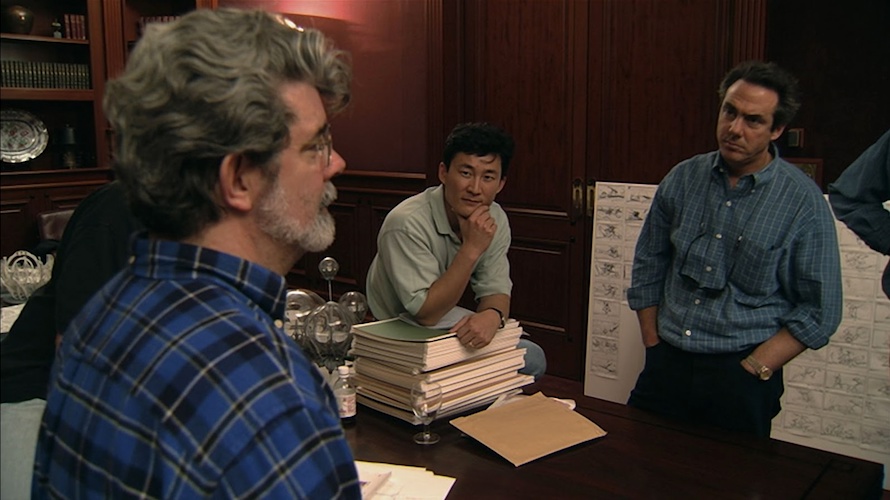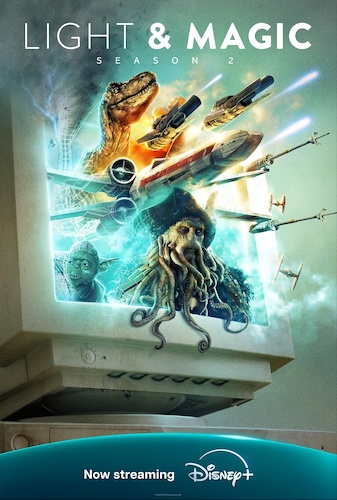Q&A: Lucasfilm Executive Creative Director Doug Chiang Discusses "Light & Magic" Documentary Season 2
Doug Chiang has been working as an acclaimed concept artist and production designer at Industrial Light & Magic and its parent company Lucasfilm for more than three and a half decades, with his most famous work having been for the Star Wars prequel trilogy, Rogue One, and The Mandalorian. This week Laughing Place was invited to participate in a press conference for the new second season of the Disney+ documentary series Light & Magic, in which Chiang is a featured interviewee, and below is what shared about his experience.

“It was just amazing," Doug Chiang began about what it was like to watch the finished second season of Light & Magic. “I mean, for one, I've forgotten a lot of that [period] and [it was great] to see everybody– all the old faces, and to hear all the old stories again just brought back so many wonderful memories. It's funny because, [when we were going through it, you don't think about that. You're just busy trying to innovate and create and, for me anyways, fulfill George [Lucas’s] vision. I never really stopped to look back [at the process], so when Joe put this together, for me it was terrific. It was surreal in the sense that I was like, “Wow, that was a really special moment." I mean, [it was] something that's pretty unforgettable because we were right at the cutting edge of a transformation for the industry and I have to say I'm very grateful to be part of that."
Chiang also touched on how his story at ILM first began. “It was interesting because I saw Star Wars when I was 15, and I knew I wanted to do sort of what [Light & Magic director and former ILM designer Joe Johnston] was doing. I actually learned how to draw by studying Joe's sketchbook from Star Wars. I really didn't go to art school and I didn't know how to do it, but I saw the people behind the scenes– I was more intrigued by the talent behind the camera. So when I was growing up in Michigan, I knew I really wanted to do that and I always thought, “OK, if I want a job in film, I should study film. And that's what I did– I studied film instead of going into art. And the irony was that I got my first job through my art, through doing storyboards, and I learned on the job. t's not the right way to do it, but I learned literally by looking at Joe's work, studying his work, looking at [concept artist Ralph McQuarrie’s] work, looking at all my artistic heroes to learn. I remember when I first got my job– my big breakthrough at ILM– it was terrifying because here I was at the company that I had dreamt of since I was 15, and I was surrounded by some of the industry's best artists. And the great thing was that everybody was so open and collaborative. It was like family, and it was amazing because in the art department, I could pick and choose different styles. So that became sort of my little mini art school where I could learn specific styles and I [could] kind of train myself.
It's not the ideal way to learn, because I developed so many bad habits. I was kind of stumbling through it and finding creative ways to do what I wanted to do without really understanding the fundamentals for it. It took years to really break through all that. And part of my strategy was to do homework– I gave myself a year-long homework of learning to do everything that I didn't want to, everything that I was afraid of like character design and creature design. And the amazing thing was that year of homework was the portfolio that George saw, and that's what he hired me for. And the curious thing is, when you're applying for our position, the way I look at it is you're auditioning– you're like an actor auditioning for a part. And when you're hired, it doesn't mean that you're the better artist; it just means that you are the right fit. I was thankful that George saw something in my portfolio that connected with him, and a lot of it had to do with me stumbling into what I enjoyed, which is combining technology with nature, and that was [how I] differentiated myself. I didn't know the term ‘impostor syndrome’ at that time, but I suffered from that terribly, and my first year and a half [working] with George was super stressful. I mean, looking back, I can laugh at it now, but I was under so much stress. I could not enjoy that at all. I felt like I did not deserve this, and it was kind of the strangest experience where I was just on edge at all times.
At that point Joe Johnston chimed in on the topic of Doug Chiang’s talents. “Doug, I just have to say that in the documentary when you say, ‘My art skills aren't that strong," everybody just rolls their eyes. Come on, Doug. Here's the thing: working with Ralph on the Original Trilogy, I'm a designer and a little bit of an illustrator. Ralph is an illustrator, but he can also design. Ralph and I had to work together and sort of trade ideas back and forth. You can do both– you have both skills, [is] basically what I'm saying. Your art is way beyond what I could do in a way, [and] in a way what Ralph could do, but you combine both disciplines: design and the ability to illustrate and render. Don't ever say your art skills are not that strong, because it's like a joke. [laughs] Come on."
“That means the world to me because I did not feel that at all," responded Chiang, who then continued to talk about the process of designing the look of the Star Wars prequels. “I had spent 6 years at ILM prior to working with George [directly], and I was used to solving problems based on the tools that we had available. And I remember during some of the earliest design briefs, George said, ‘Don't worry about any of that; just design. Do pure design, don't worry about execution. And so a lot of the stuff that we were doing both in designs for sets, for characters, and on the storyboard, we were just not even worrying about how to do it. We literally just filled everything in that George wanted to put on screen, and then we literally would say, “OK, I'm passing the buck over to [the effects artists] now. It was stressful for the first year and a half to design it all, but [then] the execution, it [was] up to John [Knoll] and Rob [Coleman]. It's just like, “Good luck!"
Chiang also responded to a question about the best way to break into the production design field these days. “I work with so many super talented artists, and we all took different paths to success, so there's many, many different ways. One, I would say go to art school, if you can– would highly recommend that. And then the other part is if you want to be a better artist, keep a sketchbook– just draw. Draw every day. I still do that every day. My morning routine is I draw for half an hour– I do sketches, and it's just for fun. Part of that is because during my day job, I don't have time to do my own personal art, and you have to develop that part of it. It's really important. As any student or anybody who wants to get into this industry, it's really [important to] just do what you can to be a better artist for yourself. The second part, which is really big, is [that] film is a collaborative endeavor. You really have to work well with people and I work with people that I enjoy working with. That means I look for character and personality first. Talent is second for me. I’d rather work with a great team, because I know that we will succeed, versus working with somebody who's super talented but maybe a little bit challenging to work with. Those are my two go-tos: one, get your skills and then two, just be very collaborative."
All three episodes of Light & Magic season 2 will be released tomorrow, Friday April 18th, exclusively via Disney+.
More on Light & Magic:



